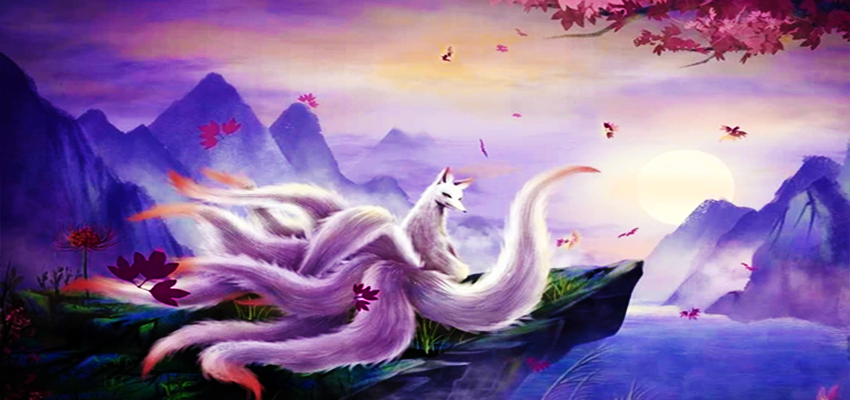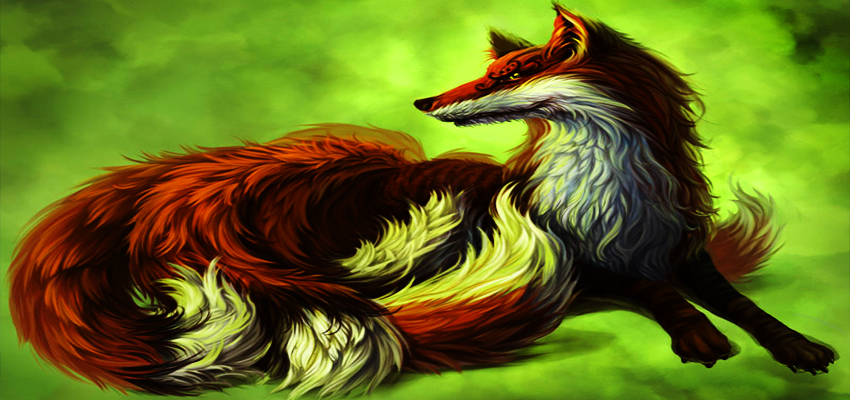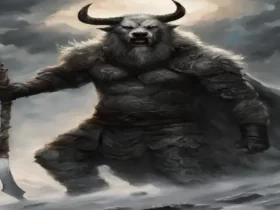The nine-tailed fox in Korean mythology is known as the Kumiho and sometimes Gumiho. When we think about Kumiho spirits in Korean mythology, there is plenty to think about. They are fascinating creatures, and at the same time, incredibly dangerous. These mystical beings are also often mistakenly thought to be Japanese Kitsune, as they share similar traits. They are also mistaken for the Chinese Huli Jing nine-tailed fox. However, they share a substantial amount of similarities with them as well but in many ways, Kumiho are quite different from their cousins.
So what exactly is so special about these seductive fantastical temptresses?
1 Kumihos Are Evil Shapeshifters But Still They Show Demonic Features After Metamorphosing Themselves

In Korean mythology, the nine-tailed magical fox spirits known as Kumiho or Gumiho can take on the form of young and beautiful women. As these shapeshifters completely transformed into human form, they can act and behave like a human but they still retain some features that used to be recognizably theirs. However, the parts most unique to the fox still stand out such as the paw-like feet of these foxes or their ears atop their heads. The changes in their forms don’t change the things they do or the consequences they may cause. Their behavior, character, and end goal (Intents) remains unchanged no matter which form they take.
2Mostly Kumiho Is Known From Their Evil Spirit Unlike Japanese Or Chinese Foxes
When you see the word “kumiho”, you might think of Japanese or Chinese foxes, fairy tales and stories. As opposed to Chinese and Japanese foxes, which are typically depicted as good spirits, Koreans take a much more malicious approach which means Kumiho are always entirely evil. Put simply, the Kumiho that is most manifested in Korean mythology is sometimes even portrayed as being morally neutral or good, but this may not be the case mostly according to Korean myths that still have survived.
3 Legends Say If Kumiho Abstains From Human Flesh For 1000 Years, It Can Become Human

In Korean mythology, the Kumiho are a type of spirit. However, they can be classified as evil and are often portrayed as nine-tailed spirits rather than fox like creatures. The Japanese Kitsune on the other hand, which represent actual foxes that evolve more tails and reach greater power levels as it ages, the Kumiho have no moments in their early life where they have fewer tails or lower powers.
Though Kumihos do age, maturing with time, this is not to say that they can’t change. Many people believe in Korean legends that if a Kumiho focuses all of their time (thousand years) on escaping from eating human flesh, it will eventually lead to them transforming into a human. However, this doesn’t seem to occur usually because most Kumiho spirits can’t live away from human flesh for that prolonged time.
4 Does The Kumiho Always Attack Those She Has Seduced?

Kumiho is predominantly an evil spirit who entices young men (usual victim) like a Jorogumo or a Huldra and induces them into marriage but this isn’t always so.
For example, in one story, The Emperor’s Kumiho Daughter-in-Law, a Kumiho marries the son of the emperor. The Kumiho didn’t feast on the Emperor’s flesh or energy like most predators. Instead, it targeted unsuspecting people in his court to collect the energy they unknowingly wore. There was a hidden motive for the Kumiho to marry the Emperor’s son. Based on this excerpt, Kumiho was using her connection to the emperor’s son to get not just one, but multiple innocent men for herself. After finding that many people were missing, the Emperor became increasingly concerned. So he asked the hero to find and eliminate Kumiho, the hero goes on to do as he was asked, and that’s precisely what happened.
5 Regardless Of Her Evil Nature, Gyuwon Sahwa Text Mentions About Her Generous & Helpful Nature Towards Human

Kumiho is a Korean spirit who is typically portrayed as not purely malevolent in many myths. There are some myths that depict Kumiho as not being exclusively malicious. For instance, there’s the well-known Gyuwon Sahwa text, which was re-written by an author in the early 20th century. It’s said that this text is dependent on earlier texts that were composed around 1675.
This book is an in-depth look at a variety of aspects of Korean history. It also lists myths and legends, describing many different Kumiho in one article. In some mythologies, the Kumiho are depicted as generous forest spirits who hold books into their jaws. Still, the Gyuwon Sahwa is not a usual way for Korean tales to end, which means the Gyuwon Sahwa is a detraction to the rule.
6 The Kumiho Myths May Be An Adaptation Of The Japanese Kitsune Legends But Still They Differ In Physical Appearance

The Korean and Japanese nine-tailed fox spirits have a lot in common, but they also have some key differences.
1- Most people who believe all are malevolent, which is what makes it difficult to distill some aspects of the Kumiho and the Kitsune. In many instances, Kumiho are mostly considered malevolent while kitsune are morally unclear; they can act in a variety of ways from good to evil.
2- Although Kitsune’s tails are thought to be the shortest than that of the Kumiho, Kitsune’s claws are also much longer comparatively.
3- Kitsune and Kumiho are both foxes who can take human form. Kitsune have fox ears that stay upright on their head when they’re in human form, even when they’re not. Kumiho, on the other hand, begins with human ears and might or may not have fox ears.
4- These two different foxes have some features that differ, their feet are what generally set them apart. The Kumiho has an anomaly of having fox paws, while Kitsune feature a blend of both human and fox-like feet instead. Exhaustive, the appearance of a Kitsune is more wild than one from a Kumiho because of its mischievous feet.
5- The magical powers and intelligence of the Kumiho spirits come from a specific type of item. “Yeowoo guseul” beads in their mouths are particularly important, as they are said to give power and intelligence to these foxes. It also can be quite common for Kitsune to be depicted with such an item but nope as highly as Kumiho.
An interesting theory suggests that the Kumiho myth was an adaptation of the Kitsune myth during the time of Japanese aggression on Korea (Imjin Wars) in the end of 16th century. While many Koreans view these spirits as evil, some say it would describe why they attribute to hidden meanings and complex stories about them.
It’s more likely than that the myth of an invasion during the 16th century lasted for only 6 years and was transferred more gradually and extended even before the war with many interactions over the years. On the other hand, some people might point to the presence in China of a nine-tailed Huli Jing mythological creature that is highly thought of. It might have come from the Chinese impact and their nine-tailed mythical beast.
7 Kumiho Is Also Mostly Different From Chinese 9 Tailed Fox Spirits Huli Jing

Kumiho are slightly different from the Chinese Huli Jing, and there are many differences.
1- With the Huli Jing, there is a greater level of moral ambiguity that can be found within it compared to a Kumiho. Most of the time, Huli Jing is as morally indistinct as their animal sign, just like their spirit animal, the Kitsune. A creature Kumiho is rarely good, but you’ll always find a bad one.
2- The Huli Jing is usually depicted in a variety of ways, but it’s primarily been depicted with human feet. Kumiho has fox paws.
3- The tails of the Huli Jing tend to be slightly shorter than those of the Kumiho and slightly longer than those of the Kitsune.
4- Huli Jing are known for having compact and plump coats than the Kumiho, who have a soft coat. The Kitsune has a similar coat to the Kumiho and it’s nice and fluffy to the touch.
5- It’s not unusual for mythical Korean creatures to have reversed features in their depictions. Despite the resemblance in their appearance, Korean folklore tells that Huli jing’s hands are often replaced with fox paws, while the Kumiho has human hands.
8 Kumiho Is Known For Metamorphose Into A Seductive Woman To Lure Men

The form of metamorphosis that Kumiho takes when they change into a human-like form is a young maiden (traditional form). This makes it easy for them to seduce their victims and ensnare within their webs of seduction.
Now, some people might be wondering what a Kumiho is exactly. There are many forms the Kumiho can take other than a nine-tailed fox. For instance, in The Hunter and the Kumiho myth hunter came across a nine-tailed fox which was carving its teeth into a human skull. Before he was able to hunt the fox, the animal started to metamorphose into an old woman – the exact old woman whose skull it had been eating moments before. The fox ran away when it realized its mistake. The hunter started to pursue it, which then ended up in a nearby village.
The Kumiho let itself into the home of an elderly woman (hunter) who had a nest of young children and It would pretend to be a mother and try its best to get close to children. The hunter warned the children of this imposter and made noises that this wasn’t their mother and pursued the Kumiho far.
9 In Few Exceptional Instances, Kumiho Can Also Be Converted Into Males

In old Korean tales, a Kumiho is usually portrayed as female, but there are a few exceptions. We are not sure if it’s somewhat unusual for them to become male. The only myth we know of where one transgressed into an adult man was The Maiden who Discovered a Kumiho by way of a Chinese Poem.
A Kumiho might look like a woman in its earlier stage, but it is actually a young man in disguise. There Kumiho had transformed into an under-age man, and deceived the maiden into marrying him. It’s hard to find other such stories where the genders of both the victim and the Kumiho are reversed, there is this one story where it happens.
10 They Like To Consume Human Liver & Heart

The nine-tailed fox’s ability to metamorphose (Transform) into a pretty young woman seems to be the most popular of its abilities, but they are actually very dangerous. They tend to trick and distract people so that they will have their way or attack them at all costs.
Kumiho takes pleasure in banqueting on human meat, especially on their livers or hearts. There have been many cases reported of Kumiho spirits wandering cemeteries to disinter fresh corpses. These spirits, which were originally female, would then eat the carcass in order to satiate their cravings, when they’re not able to kill people in the living world.
11 Kumiho Can Steal Your Spirit’s Energy
Kumiho also has a magical “Yeowoo Guseul Marble” to extract people’s crucial energy. In some cases, this comes in the form of a deep kiss delivering a steady flow of power.
If someone were to manage to take and swallow the Kumiho’s Yeowoo Guseul Marble during a deep kiss, people would not only survive but gain access to even more knowledge about all three aspects of life, “sky, land and people”.
12 Fear & Danger Are The Main Symbolism Of Kumiho

Kumiho spirits are a representation of both the dangers that waylay in the forests and the fears people have about them. Kumiho are spirits that take on the appearance of young women to lure people into their dangerous realm. Some scholars say what really attracted people’s attention was their beauty and evil intent.
There are some myths about the dangers of beautiful women, who in ancient cultures were often considered to be a cause for problems because they can destroy families and the destructiveness of beautiful women. People fear beautiful women and the wild foxes that they believe they’re trying to punish. The Kumiho myth made these two things into one symbol by making the beautiful woman, often a young girl, and the fox into one frightening image.
Though it is unclear whether the Kumiho myth really originated in Japan, if this were true, this can help explain why they’re always considered evil. The nine-tailed Kitsune are often morally neutral or even benevolent in Japanese mythology.
The Koreans are probably distorting this myth and turning it into something negative because they were likely quite unhappy with the Japanese at certain times. This can be a common version of their culture given the unfortunate history between these two nations.
13 From Lovecraft’s Imagination To Video Games, Kumiho Creature Has Claimed Its Place In Mass Culture

Nine-tailed foxes are appearing more and more in modern pop culture. Eastern manga, anime, video games and TV series use these mythological creatures as inspiration. The West is also increasing its usage of the unusual mythological creature so it’s no surprise that some people find them an inspiration for their own work.
In comparison to mythical beings like Kumiho, Kitsune, and Huli Jing, it can be difficult to determine which mythical creature a definite character was based on.
For instance, Ahri is a character from the MOBA video game League of Legends. The character is a beautiful magical temptress with long, fox-like ears and nine long fox tails. There’s a notion that she doesn’t actually have fox paws at all – just beautiful fur patterns on her feet and hands. Her role as a character is often seen in a positive light or even one with moral ambiguity.
Generally, this would make sense with the kitsune myth because the Kumiho are portrayed as more of a villain than the kitsune. Many people in Korea believe that Kumiho spirits are the basis for her. Is it fair to say that she’s both based on a Kumiho spirit and a kitsune?
You might be surprised to see that there are quite a few other characters based on Kumiho, Kitsune, or Huli Jing. 1994 horror film The Fox with Nine Tails is one of the many examples of characters based on Kumiho, Kitsune, or Huli Jing. Some famous TV and film examples include a 2010 SBS drama My Girlfriend is a Gumiho, an episode of HBO’s 2020 TV series Lovecraft Country and numerous others.
In Conclusion

These nine-tailed fox spirits are delectable and complicated. You may be familiar with the Korean Kumiho, as they are similar to Japanese Kitsune and Chinese Huli Jing spirits. They’re intriguing with a mixture of Asian myths, so much so that it’s not all clear which one came first.
Despite the incredibly high level of skill and power, their malice and appetite for human flesh make them unique among other Asian counterparts. What tricks do magical foxes use to get what they want? It’s hard to say because they’re the famous shapeshifters in folklore. They can change their shape and lure unsuspecting men into their deaths, but they also have other skills It means; they’re not limited to just this though, they can do utterly a little more than that.





